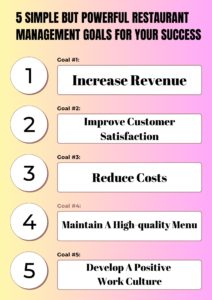First Published: 6 January 2023
Restaurant Management Goals
Restaurant management is the process of overseeing a restaurant’s daily operations, such as financial management, menu planning, marketing, and personnel management. Setting restaurant management goals and objectives, developing and implementing policies and procedures, and making decisions about the restaurant’s direction and growth are all part of restaurant management.
Restaurant managers are responsible for ensuring the restaurant’s profitability and smooth operation, as well as maintaining high quality and customer service standards. It necessitates a mix of business skills and knowledge of the food and hospitality industries.
What is the main objective of a restaurant manager?
The main objective of a restaurant manager, a role that requires diverse skills and responsibilities, is to ensure smooth operations, maintain high service and cleanliness standards, manage staff effectively, optimise profitability, handle customer relations, and uphold the restaurant’s reputation. This multi-faceted role is crucial to the success of a restaurant, requiring a manager to be a leader, a strategist, a communicator, and a problem-solver all at once.

Importance of setting goals in restaurant management
Use SMART Goals
SMART goals are abbreviated as:
- Specific
- Measurable
- Achievable
- Relevant
- Time-Bound
Defining these criteria in connection to your goal ensures that your goals are met within an acceptable time frame. Using SMART Goal setting is essential in restaurant management for several reasons:
- Goals provide direction and focus:
By establishing specific goals, a restaurant manager can identify what they want to accomplish and devise a strategy to achieve those objectives. This helps to focus the team’s efforts and ensures that everyone is working toward the same goal.
- Goals assist in measuring progress:
Setting goals enables a restaurant manager to track progress toward achieving those objectives.
This can assist in identifying areas of success as well as areas that may require improvement.
- Goals motivate and engage employees:
When employees understand the restaurant’s goals and how their work contributes to those goals, they may be more motivated and engaged in their jobs.
- Goals drive continuous improvement:
A restaurant manager can continuously strive to improve the restaurant’s operations and performance by setting and working toward specific goals.
- Goals provide a sense of accomplishment:
Achieving goals can provide both the restaurant manager and the team with a sense of accomplishment and pride, which can be a powerful motivator.
Overall, goal setting is an important aspect of effective restaurant management because it helps to ensure that the restaurant is heading in the right direction and progressing toward its objectives.

Restaurant Management Goals
Here are some ideas of restaurant management goals that a restaurant may set as the year begins:
Goal #1: Increasing revenue
Strategies for increasing sales, such as menu optimization, promotions, and upselling
A restaurant manager can use several strategies to increase sales, including:
Menu optimisation:
Selecting and pricing menu items with care can help to increase sales.
This may include conducting market research to understand customer preferences, offering a variety of dishes at different price points, and updating the menu regularly to keep it fresh and appealing.
Promotions and discounts:
Offering promotions or discounts can help drive customers to the restaurant and encourage them to spend more money.
Examples are limited-time offers, discounts for specific customer groups (such as students or seniors), or special deals on specific menu items.
Encourage customers to upgrade their orders or add additional items to increase sales.
For example, a server may suggest a more expensive entree or ask whether the customer would like to add a dessert or side dishes.
Marketing and advertising:
Targeted marketing and advertising can help attract new customers and increase sales.
This could include developing social media campaigns, forming partnerships with local businesses, or running print or online advertisements.
Loyalty programmes for customers:
Offering rewards or incentives for repeat business can encourage customers to return to the restaurant and spend more money.
Hosting special events like themed dinners or wine tastings can help drive sales and attract new customers.
Improved customer service:
Providing excellent customer service can contribute to a positive customer experience, encouraging customers to return and spend more money at the restaurant.
The role of marketing in driving revenue in restaurants
Marketing can help restaurants increase revenue significantly in a variety of ways, including:
Attracting new customers:
Effective marketing efforts can help to attract new customers to the restaurant, thereby expanding the customer base and increasing sales potential.
- Marketing can help create a positive customer experience and build customer loyalty, encouraging customers to return to the restaurant and spend more money.
- Marketing efforts can help to increase the average transaction value by encouraging customers to purchase higher-priced items or to add additional items to their orders.
- Marketing can assist in promoting special events or promotions, such as limited-time offers or discounts, which can drive sales and bring in new customers.
Creating a positive brand image:
A strong brand image can help a restaurant differentiate itself from competitors and create a positive perception among potential customers.
This can help to increase sales and customer loyalty.
Generally, a well-planned and executed marketing strategy can be a significant revenue driver for restaurants.
It can help to attract new customers, encourage repeat business, and promote special events or sales promotions.

Goal #2: Improving customer satisfaction
The benefits of a positive customer experience in a restaurant
A positive customer experience can provide several advantages to a restaurant, including:
Increased customer satisfaction:
When customers have a positive experience at a restaurant, they are more likely to be pleased with their visit and to form a favourable opinion of the establishment.
Increased customer loyalty:
Customers who have a positive customer experience are more likely to return to the restaurant and recommend it to others.
Increased sales:
Satisfied customers are more likely to spend more money and return more frequently, resulting in higher sales.
Positive word-of-mouth:
Satisfied customers are more likely to tell others about their positive experiences, which can help attract new customers to the restaurant.
Improved reputation:
A positive customer experience can help the restaurant build a positive reputation, which can help attract new customers and retain existing ones.
As a whole, a positive customer experience is critical for a restaurant’s success.
It can increase customer satisfaction and loyalty, which can boost sales and improve the restaurant’s reputation.
Resolving issues and problems effectively:
It is critical to handle issues and problems effectively to maintain customer satisfaction. Responding quickly to customer concerns or complaints and going above and beyond to meet customer needs will enhance your reputation in the customer’s eyes.
This could include training employees to handle difficult situations, establishing a process for dealing with customer complaints, and apologising and making amends when necessary.
Providing excellent customer service:
Customer service can play a significant role in determining customer satisfaction. In general, a restaurant’s customer satisfaction can be improved by providing prompt service, high-quality food, a clean and welcoming environment, excellent customer service, and effective problem-solving
Strategies for improving customer satisfaction, such as prompt service, high-quality food, and effective problem-solving
There are several strategies that a restaurant manager can use to improve customer satisfaction, including:
Making sure customers are served promptly and efficiently can help to create a positive experience and reduce frustration.
This may entail training employees to be responsive and proactive in meeting the needs of customers.
Serving high-quality, appetising food: A key factor in customer satisfaction is serving high-quality, appetising food.
This could include using fresh ingredients, carefully preparing dishes, and providing a variety of options to meet various dietary needs.
Keeping a clean and welcoming environment: A clean and welcoming restaurant can make a good first impression and improve the customer experience.
Maintaining cleanliness standards, decorating the restaurant appealingly and invitingly, and ensuring that the restaurant is well-maintained are all examples of this.
Providing excellent customer service: Customer service can play a significant role in determining customer satisfaction.
This could include training employees to be friendly and helpful, responding quickly to customer concerns or complaints, and going above and beyond to meet customer needs.
Resolving issues and problems effectively: It is critical to handle issues and problems effectively to maintain customer satisfaction.
This could include training employees to handle difficult situations, establishing a process for dealing with customer complaints, and apologising and making amends when necessary.

Related articles:
Restaurant Profit And Loss Statements
How To Improve Restaurant Profits
Restaurant Inventory Management System
How To Become A Restaurant Manager
Goal #3: Reducing costs
The importance of cost control in a restaurant’s financial health
Increasing cash flow:
By controlling costs, a restaurant can increase its cash flow by increasing profits and decreasing expenses.
This can assist the restaurant in meeting its financial obligations while also investing in growth.
Increasing competitiveness:
A restaurant can become more competitive in the market by carefully controlling costs, which can help attract customers and drive sales.
Furthermore, effective cost control is critical for a restaurant’s financial health.
A restaurant can increase profitability and improve its overall financial performance by reducing expenses, increasing efficiency, and improving pricing and cash flow.
Strategies for reducing costs, such as inventory management, energy efficiency, and negotiating with suppliers
There are several cost-cutting strategies that a restaurant can employ, including:
Inventory management:
Proper inventory management can help to reduce waste and costs. This may entail implementing a system for tracking inventory, establishing par levels, and regularly reviewing inventory levels to ensure accuracy.
Energy efficiency:
Using energy-efficient practices can help you save money on your utility bills.
Using energy-efficient appliances, turning off lights and equipment when not in use, and using low-energy lighting are some examples.
Negotiating with suppliers for better pricing or terms: Negotiating with suppliers for better pricing or terms can help to reduce costs.
Negotiating bulk discounts, exploring alternative suppliers, or negotiating longer payment terms could all be part of this.
Streamlining processes can help to reduce waste and save time, which can lead to cost savings.
This could include using technology to automate tasks, reorganising workflows, or removing unnecessary steps.
Reducing employee turnover:
High employee turnover can be expensive due to the costs of training new employees as well as lost productivity.
Implementing employee retention strategies, such as competitive benefits and fostering a positive work environment, can help to reduce costs.
Reducing food waste: Food waste can be expensive for restaurants.
Reduced food waste strategies, such as carefully planning menus and implementing portion control, can help to reduce costs.
Essentially, there are numerous strategies a restaurant can employ to cut costs and improve financial performance.

Goal #4: Maintaining a high-quality menu
The role of menu development in attracting and retaining customers
Menu development can be extremely effective in attracting and retaining customers in a restaurant.
Menu development can influence customer appeal in a variety of ways, including:
A varied menu with a variety of options can help to attract and retain customers by allowing diners to find dishes that appeal to their preferences and dietary needs.
Using high-quality ingredients:
Using high-quality, fresh ingredients can aid in the creation of dishes that are appealing to customers.
This can aid in attracting and retaining customers looking for a high-quality dining experience.
Creating visually appealing dishes:
Presenting dishes in a visually appealing manner can help to attract customers and leave a good impression.
Keeping the menu fresh and interesting:
Adding new and interesting dishes to the menu regularly can help to keep customers engaged and encourage them to return.
Providing value:
Offering dishes that are reasonably priced and provide good value can aid in attracting and retaining customers.
Broadly speaking, menu development is critical to attracting and retaining customers in a restaurant.
A restaurant can create a menu that appeals to customers and encourages them to return by offering a variety of options, using high-quality ingredients, creating visually appealing dishes, keeping the menu fresh, and offering value.
Strategies for menu planning and selection, such as market research, customer feedback, and seasonal offerings
A restaurant can use several strategies to plan and select dishes for its menu, including:
Conducting market research can assist in identifying customer preferences and trends in the local area.
This could include conducting customer surveys, analysing industry data, or keeping track of popular menu items.
Soliciting customer feedback:
Obtaining feedback from customers can assist in identifying dishes that are particularly popular or unpopular, as well as providing insights into what customers are looking for in a menu.
Seasonal offerings include:
Seasonal dishes can help to keep the menu fresh and interesting while also taking advantage of the availability of certain ingredients.
Menu diversification:
Providing a variety of options, including dishes at various price points, flavours, and styles, can help to appeal to a wide range of customers.
Working together with the chef:
Working closely with the chef to develop and test menu items can help ensure that the dishes are appealing as well as well-prepared.
Menu planning and selection is a complex process that involves a variety of factors such as market research, customer feedback, and ingredient availability.
A restaurant can create a menu that appeals to customers while also supporting the success of the business by carefully planning and selecting dishes for the menu.

Goal #5: Developing a positive work culture
The relationship between employee satisfaction and customer satisfaction
In a restaurant, there is a strong correlation between employee and customer satisfaction.
Employees who are happy in their work and feel valued and supported are more likely to provide excellent customer service, which can lead to higher customer satisfaction.
When employees are dissatisfied or unsupported, it can lead to poor customer service and a negative customer experience.
Employee satisfaction in a restaurant can affect customer satisfaction in the following ways:
Customer service:
When employees are happy with their jobs, they are more likely to give customers prompt, friendly, and helpful service.
This can improve customer satisfaction and create a positive customer experience.
Food quality:
Employees who are motivated and engaged are more likely to prepare food to the highest standards.
This can lead to increased customer satisfaction with the food’s quality.
Cleanliness:
When employees are happy with their jobs, they are more likely to keep the restaurant clean.
This can make a good impression on customers and increase their satisfaction.
Significantly, employee satisfaction is an important factor in restaurant customer satisfaction.
A restaurant can improve customer satisfaction and loyalty by creating a positive work environment and supporting its employees.
Strategies for building a positive work culture, such as communication, training, and recognition programs
A restaurant can implement several ways to promote a positive work culture, including:
Communication:
Creating open lines of communication between management and employees can aid in the development of a positive work culture.
This could include regular meetings or using communication channels like email or Slack to keep employees informed and encourage feedback.
Continuous training and professional development opportunities can help improve employee skills and knowledge, which can contribute to a positive work culture.
Employee recognition programmes:
Recognizing and rewarding employees for their contributions can aid in the development of a positive work culture.
This could include instituting a formal recognition programme, such as an employee of the month award, or simply thanking employees for their efforts.
Employee involvement:
Including employees in decision-making and giving them ownership over their work can help to foster a positive work culture.
This could include soliciting employee feedback on issues such as menu development or policy changes or allowing employees to take on leadership roles.
Management that is open to feedback, willing to listen to employee concerns, and responsive to employee needs can all contribute to a positive work culture.
In general, creating a positive work culture entails making employees feel valued, supported, and engaged.
Positive work culture in a restaurant can be created through a combination of effective communication, training, recognition programmes, employee involvement, and supportive management.

Conclusion
The importance of setting and working towards specific goals in restaurant management
Setting and achieving specific goals is critical in restaurant management for several reasons:
Goals provide direction and focus. By establishing SMART goals, restaurant managers can identify what they want to accomplish and devise a strategy to achieve those objectives. This helps to focus the team’s efforts and ensures everyone works toward the same goal.
Goals aid in tracking progress: Setting goals enables a restaurant manager to monitor progress toward achieving those objectives. This can assist in identifying areas of success as well as areas that may require improvement.
Goals motivate and engage employees: When employees understand the restaurant’s goals and how their work contributes to those goals, they may be more motivated and engaged in their jobs.
Goals drive continuous improvement: A restaurant manager can continuously strive to improve the restaurant’s operations and performance by setting and working toward specific goals.
Goals provide a sense of accomplishment: Achieving goals can provide both the restaurant manager and the team with a sense of accomplishment and pride, which can be a powerful motivator.
Finally, goal setting is an important aspect of effective restaurant management because it helps to ensure that the restaurant is heading in the right direction and progressing toward its objectives in a structured way.
(FAQ) Frequently Asked Questions And Answers
What are the main goals of a restaurant?
The main goals of a restaurant typically include:
- Providing excellent customer service.
- Serving high-quality food.
- Maintaining a positive reputation.
- Achieving profitability.
- Creating a welcoming atmosphere for guests.
What is an example of a SMART goal for a restaurant?
A SMART goal for a restaurant, a testament to the strategic thinking and planning required in this industry, could be: “Increase monthly revenue by 15% within six months by implementing a new marketing strategy to attract more customers during off-peak hours.” This goal sets a clear target and outlines a specific strategy, demonstrating the importance of foresight and planning in the restaurant business.
What is good management for a restaurant?
So, what does good management for a restaurant look like? It’s about being a great leader, communicating clearly, scheduling efficiently, training your staff well, managing your inventory, ensuring food quality and presentation, following health and safety regulations, and, most importantly, keeping your customers happy for repeat business and positive reviews.

